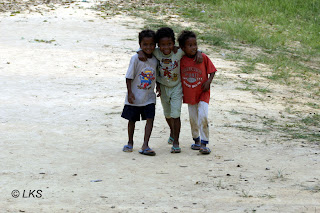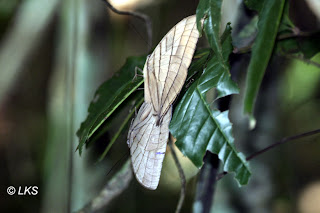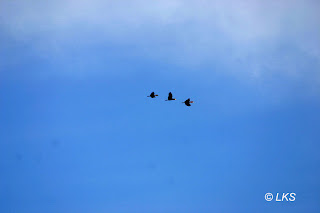 The Temengor Lake
The Temengor Lake  Group photo before boarding the boat. 4th from right was our leader Connie.
Group photo before boarding the boat. 4th from right was our leader Connie. 
Bridge over Temengor Lake, connecting mainland to Banding Island.
The exact location of the Discovery Island

A closer view
Dormitory type of accommodation at the boat house was chosen even though the chalets were available on the island.

The chalet.
 Rear view of the chalet. Notice the roofless bathroom? Marvellous experience.
Rear view of the chalet. Notice the roofless bathroom? Marvellous experience.The interior. Comfortable enough for 2 - 4 person.
Food – no problem. The cook prepared tasty food for breakfast, lunch and dinner. The first night, we had steamboat, and the famous Ipoh "Salt-baked Chicken" complimented by a group of Singaporean visitors, while on the second night, barbeque was served. Both dinners were held at the waterfront restaurant.
The guests could prepare their own tea or coffee at anytime they wanted. Tea-bags, coffee (3 in 1), sugar, creamer and hot water were always available.
Steve was a good host. He was not selfish in sharing his knowledge of the Temengor lake. He entertained us well through-out our stay.
This resort was still developing. The bathrooms and toilets were clean. It was relaxing. One can sit by the side of the boat to be entertained by around 6 to 7 species of fish displaying their skillful ‘aquatic ballet’. This resort’s webpage is available at http://www.ttdi.com.my/
The Aborigines (Orang Asli)
The Jahai and Temiar are the two main orang asli groups of Belum Temengor rainforests. They are dark, short with curly hair. They are friendly. They built their houses by the lake side. Fishes from the lake are a main source of high protein diet for their children to grow.
Typical Orang Asli settlement by the lake-side
 View of another Orang Asli Settlement
View of another Orang Asli Settlement Catching fish to supplement their diet is one of their major activity.
Catching fish to supplement their diet is one of their major activity. The Three Musketeers
The Three Musketeers The two loving brothers, even though they didn't look at each other while this photo was taken
The two loving brothers, even though they didn't look at each other while this photo was taken
Logging
Signs of logging activities still exist. At times, you could see clouds of dust suddenly rised from the forest floor. This was due to the timber lorries rolled over the dry logging tracks.
 Logging activities
Logging activities  Logs ready to be transported out.
Logs ready to be transported out.One local resident told us, what we saw from the lake were beautiful green vegetations, but behind them, trees been fallen, the forests at the other side were “bold”.
Sungai Sara, once a heaven for anglers, is now clogged up with debris of wood as a result of logging. “No more Sebarau and Baung”, they claimed.
The once crystal clear Sara River
Animal Life
It is needless to describe wild life in this area. Everyone knew this tropical forest was infested with lots of wild animals, but of course, in the midst of the thick jungle, I supposed they could see us, but we could not see them. So, watch out friends, we’re being watched.


 Damselfly
Damselfly At the Halong River mouth, traces of elephants’ footprints and their excreta were here and there. A hut which was built recently was apparently destroyed by these giants. Prominent footprints were seen inside the fallen hut.







Another star bird was the Oriental Dwarf Kingfisher Ceyx erithacus, my lifer. It was spotted at the Halong River mouth. This bird was quite friendly and posed many different positions, and also showing us its hunting skills. We had a good time photographing/digiscoping it.


Want to see the world’s largest, rare and well known flower, the Rafflesia? Of course there won’t be any objection. We were taken to the south-east bay of Pulau Besar. After a careful climb up the steep river band, we walked along a path which was more like a dried-up river. The walk was easy and took us less than 10 minutes to arrive there. In fact, we visited the site twice. First visit was on Saturday, the flower was not fully bloom then.



 Cameras, binoculars, even spoting scopes were in use for a better view of this rare species. Notice the broken fence on the left?
Cameras, binoculars, even spoting scopes were in use for a better view of this rare species. Notice the broken fence on the left? The signboard - 'no plucking', not 'no stepping"
The signboard - 'no plucking', not 'no stepping"
I won't know what seed was this.
Neither this.

The red colour is striking

It was time for us to say 'Good-bye'. Thanks to Steve and his staffs for their friendliness and hospitality. Thanks to our leader Connie Khoo for her capability and efficiency to organize, and thanks to all participating members, of whom were so joyous and cooperative. I really enjoyed this trip.
 We hate to leave this serene place, but we have no choice.
We hate to leave this serene place, but we have no choice.
















